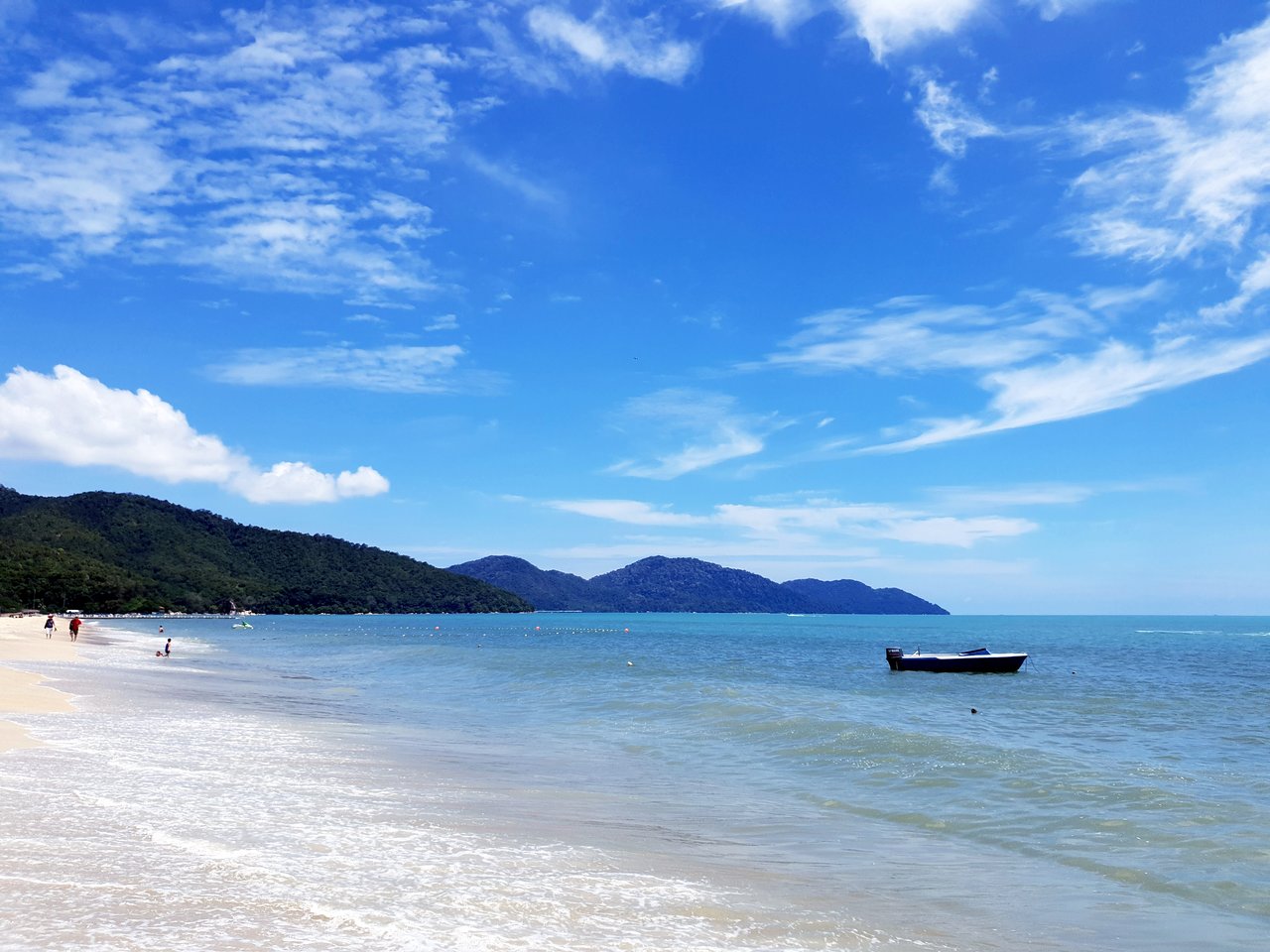
BATU FERRINGHI
One of Penang’s most popular destinations (in fact, it’s the second most popular destination after Georgetown), Batu Ferringhi consists of a long stretch of soft, white sandy beach along a winding road named Jalan Batu Ferringhi, filled with a host of accommodation and dining options. Its night market is quite legendary, while its waters are popular spots for a range of water sports activities such as jet-skiing, parasailing and windsurfing. on the contrary, whether you are looking for a wet and wild time in the water, or just interested in immersing in local culture, Batu Ferringhi has the go-to spots to accommodate all travellers. From learning how to batik-paint, visiting a charming butterfly farm, strolling through a one-of-a-kind spice garden, or enjoying watery thrills and spills in an amusement park, this area has something for everyone.
-
TRANSPORTATION
From Kuala Lumpur, a 45 minute flight to Penang Airport or you can take bus which will cost almost RM35 to Penang sentral or you can take train which will be bit costly but more faster service than bus . From Penang central you need to take ferry which will cost RM2-5 for an adult to Georgetown. Just after take off from ferry you will fin a bus station just outside the ferry station where you need to take Rapid Penang buses 101 and 102 serve the residents of the suburb, by connecting Batu Ferringhi with George Town and other destinations on Penang Island, such as Tanjung Bungah, Tanjung Tokong, the Penang International Airport and Queensbay Mall. Another bus service, the Hop-On Hop-Off service, caters primarily to tourists.This service, which utilises open-topped double decker buses, includes three stops within Batu Ferringhi – an optional stop at Miami Beach and two standard stops at Holiday Inn and Hard Rock Hotel.

ARMENIAN STREET
Armenian street is an UNESCO World Heritage Site featuring graphic street art depicting the life of the people of Penang.Making strolling through Georgetown’s streets just a little bit more exciting, in 2012 Penang’s municipal council hired London-trained Lithuanian artist, Ernest Zacharevic and charged him with breathing new life into some of the atmospheric Chinese shop-houses around the inner city. An effort to spawn awareness of the rich history of the streets, the project was a success with Zacharevic turning certain areas into thriving tourist destinations that also became the much-talked about object of attention among locals. His artwork is spread out across Penang’s city centre, along roads like Muntri Street, Weld Quay, Lebuh Leith, Armenian Street, Ah Quee Street and more.
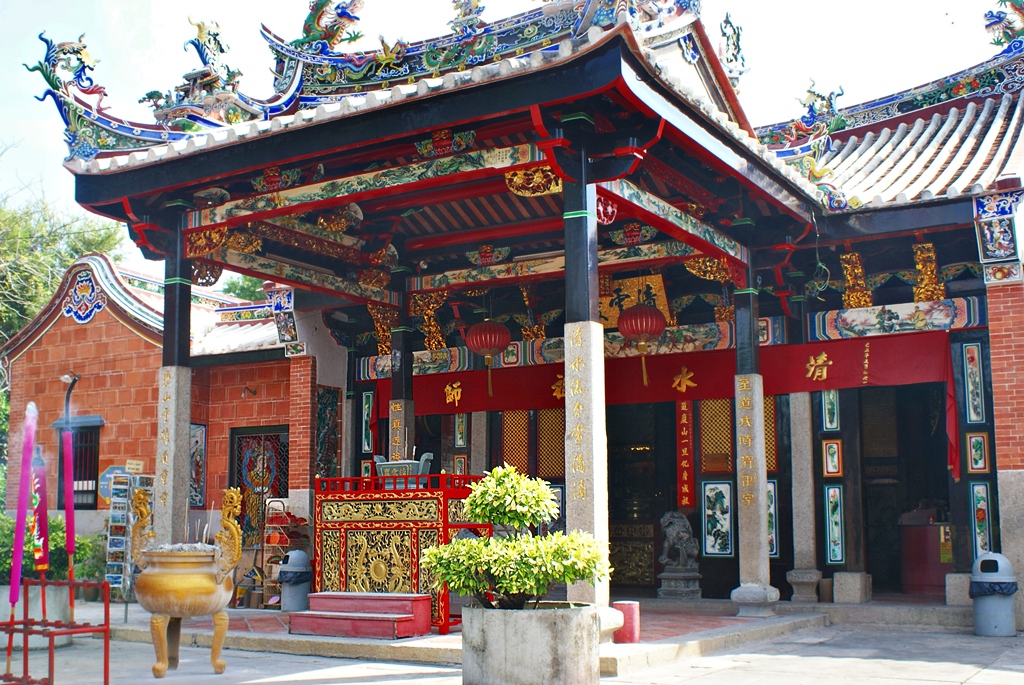
SNAKE TEMPLE
The Penang Snake Temple is about three km from the airport in Sungai Kluang, Bayan Lepas. Built in honour of Chor Soo Kong, a Buddhist priest and healer, legend has it that the monk gave shelter to the snakes and when the temple was completed after his death, they moved in on their own. After that, the snakes were believed to the disciples of the priest, so it became the home to several resident venomous Wagler’s pit vipers and green tree snakes. The temple is also known as the Temple of the Azure Cloud or Pure Cloud Temple and was constructed in 1850 as a result of a generous donation from a Scotsman, David Brown, whom Chor Soo Kong is said to have healed of an incurable disease using local medicine.
-
ACTIVITIES
There is a small exhibition annexe next door to the temple with tanks containing snakes, including pythons and cobras; the entry fee is cheap and this is where you’ll take pictures with defanged snakes (most of the snakes in the temple have had their fangs extracted). Having a photo taken while holding a snake can be slightly expensive almost RM 50, so do not give into the persistent snake handlers unless you really want to.
-
TRANSPORTATION
It is easy to get to the Snake Temple: from Georgetown there are three buses that take you to Bayan Lepas, bus numbers 302, 401 or 401E. There is not much else around the temple in the way of sightseeing attractions as it is mostly surrounded by factories and a highway, so be sure to leave the temple early to catch the free shuttle bus or be prepared to take a taxi.
-
Opening Hours:
06:00 – 19:00.
-
Price Range:
For Temple: FREE
Snake farm: Adults – RM5, Kids – RM3
ADDRESS:
Jalan Sultan Azlan Shah, Bayan Lepas Industrial Park, 11900 Bayan Lepas, Pulau Pinang, Malaysia
VISIT WEBSITE
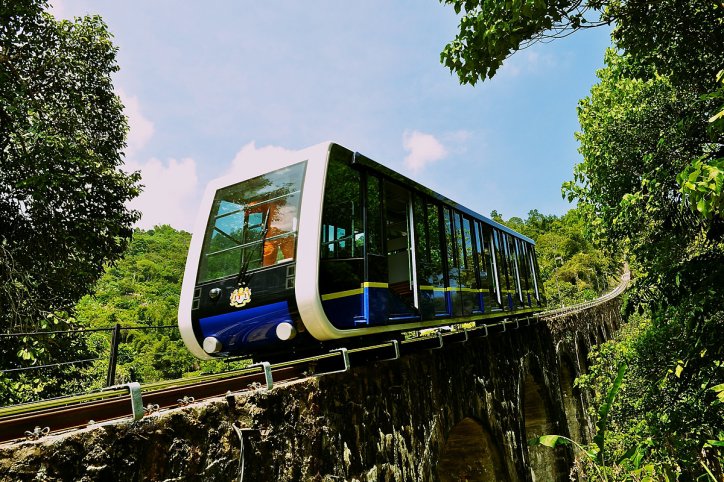
PENANG HILL
Penang Hill was the first colonial hill station developed in Peninsular Malaysia. Comprising Western Hill, Bukit Laksamana, Tiger Hill, Flagstaff Hill and Government Hill, it is located six km away from Georgetown. The hilly and forested area is the state's primary hill resort.Penang Hill covers a number of hills, with the highest point at Western Hill which is 833 m (2,733 ft) above sea level. The hill stands out prominently from the lowlands as a hilly and forested area. It was used as a retreat during the British colonial period, and is now a popular tourist destination in Penang. The top of the hill is accessible via the Penang Hill Railway from its base station at Hill Railway Station Road. To date, this funicular railway system is the only one of its kind in Malaysia, transporting over a million visitors to the peak of Penang Hill as of 2014. Set 821m above Penang’s capital, islanders call it Bukit Bendera and it is generally about five degrees cooler than Georgetown. It is the last patch of tropical rainforest in Penang so the flora and fauna here have been protected since 1960. It does not have the same prominence as Genting Highlands, Fraser’s Hill or Cameron Highlands but it is one of Penang’s best-known tourist attractions due to its fresher climate.
-
Penang Hill History
Penang Hill was discovered when soon after British settlement; Francis Light commissioned the area to be cleared to grow strawberries. Though it was never fully developed (it was difficult to carve out the forest area), it became a favourite expatriate refuge before the advent of air conditioning. Its oldest bungalow, Bel Retiro, is the holiday residence of the Governor of Penang. Today, the ridge on top of Penang Hill is known as Strawberry Hill.
-
Views from The Top
From the top of Penang Hill on a clear day you can see the mountains of Langkawi and north Kedah but it is the night time sight of lit-up Georgetown that is especially rewarding. Most people simply come to enjoy the cool, unpolluted air and walk under 30m-high trees along the nature trails. Additionally, over 100 species of birdlife, ranging from ordinary garden species to exotic deep forest inhabitants, call this hillside home. Two kilometres away from Bellevue Hotel is the Canopy Walk: this 220m walkway suspended between towering trees 30m above the dense jungle offers great views of the hillside.
-
Penang Hill Railway
The most popular way to the top of the hill is the Penang Hill Railway. Located at the foot of the hill, this Swiss-designed funicular starts out from Air Itam. Built in 1923, it is one of the world’s oldest funicular systems and has a 2,007m-long track that climbs the hill at a crawling 30-minute pace. The journey takes you past luxuriant greenery and the occasional macaque plus the bungalows originally built for British officials and other wealthy citizens. The queue for carriages can be quite long especially on weekends and public holidays: passengers have to change trains midway. Another way to the top of Penang Hill is by a five km drive up a private road accessible only to the vehicles of hillside residents: this jeep trail is a popular hiking route and starts out from the quarry at the entry of the Penang Botanic Gardens. There is a well-marked eight km path leading up from the Moon Gate (between the post office and police station) at the Botanical Gardens: it is a steep one-hour climb, but a delightful walk with plenty of places to rest along the way. There is a food court, fruit and souvenir stalls, some gardens, an exuberantly decorated Hindu temple, a mosque, a police station, a post office and an 11-room hotel (Bellevue Hotel) at the upper funicular station: the original funicular train, built in 1897, is also on exhibit here.
-
Ticket Price
Please click the visit website link below to visit to their official website and find out all details about the tour and ticket. You can buy ticket online from their as well.
-
Climate
The most important feature of Penang Hill is the cooler climate. The core summit area has an average temperature ranging from 20° to 27 °C. The mean minimum temperature is consistently below 21 °C. The hottest months are between December and April while the coolest months are between June and October. It is generally 5 degrees cooler than Georgetown.
ADDRESS:
Perbadanan Bukit Bendera, Jalan Stesen Bukit Bendera, Air Itam, 11500 Pulau Pinang, Malaysia.
VISIT WEBSITE
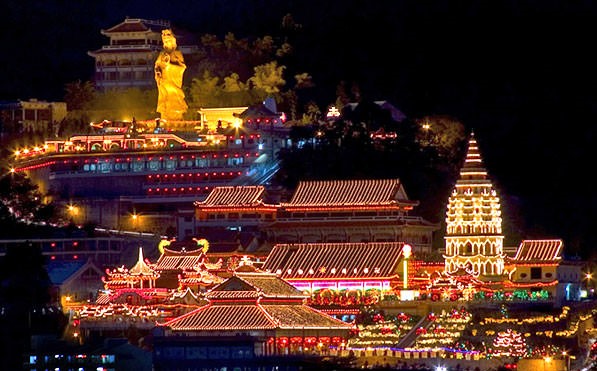
KEK LOK SI TEMPLE
Standing on a hilltop at Air Itam, near Penang Hill, Kek Lok Si is the largest Buddhist temple in Malaysia. The complex is divided into three zones while the temple grounds comprise the hill entrance, souvenir, food and drinks stalls and the turtle liberation pond. The mid section of the temple houses temples, gardens, the pagoda ; meanwhile the hilltop plays host to an enormous statue of Kuan Yin as well as more gardens and temples.
-
OTHER SCENARIO
The complex is a cornerstone of the Malaysian Chinese community. Also known as the ‘Temple of Supreme Bliss’, it features a maze of souvenir kiosks as well as a turtle and fish pond. The turtle pond – known as The Liberation Pond – was built because according to Chinese tradition, turtles symbolize longevity, strength and endurance and the act of capturing and freeing a turtle is a symbol of spiritual liberation.
Additionally, there’s a three-storey shrine with a large Buddha icon that was donated by King Bhumibol of Thailand – you can find several temples here as well as shops and a vegetarian restaurant. At the highest level there is a 36.5 metre-high bronze statue of Kuan Yin; in the future 16 ornately decorated bronze columns supporting a roof over the statue, as well 1000 two-metre high statues are planned to be built.
At the apex are a couple more temples, a fish pond, sprawling gardens and 12 animal statues that represent the Chinese zodiac. Kek Lok Si temple houses tablets and imperial Buddhist sutras gifted by Manchu Emperor Kwang Xi and Empress Cixi of the Ching Dynasty; these historic relics are kept in the temple archives. The impressive complex is usually crowded with visitors and is located approximately three kilometres from Penang Hill. -
Price Range
Entrance: Pagoda - RM2;
Incline lift - RM2
ADDRESS:
Air Itam, Georgetown
VISIT WEBSITE
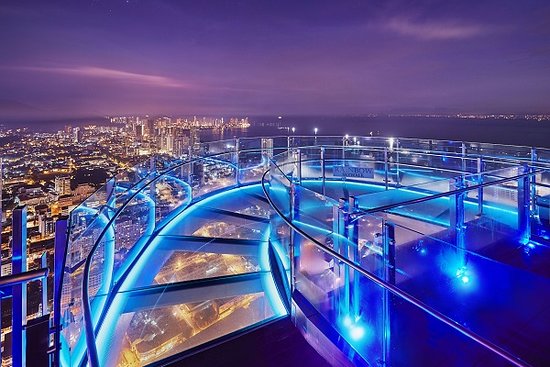
RAINBOW SKYWALK
The Top is a rooftop viewing deck in George Town, Penang — one of Malaysia’s most beautiful cities. The Komtar tower’s most famous attraction is the Rainbow Skywalk, a transparent glass walkway that lets you watch the streets and lights of Penang way down beneath your feet. But many people don’t know that you can also visit the Komtar building for English afternoon tea, with the same great views but without the entrance fee! Read on for more information about visiting the Komtar Rainbow Skywalk at The Top, Penang — including what to see and do, how to get there, and how much it costs.
-
SCENARIO
The Komtar Tower is the tallest skyscraper in Penang and at 249 metres high, it’s also the 6th highest building in Malaysia. The tower’s a bit of a jack of all trades. It’s close to George Town’s historic heritage area and most of the city’s main attractions, and it’s a shopping centre, office block, transport hub and shiny tourist attraction in one. At the top of the Komtar Tower has a viewing platform with incredible views of Penang’s city skyline, the blue bay dotted with ships, and the mountains beyond. It’s a great place to have a best views in the city.
- It has Three different viewing platforms as below
-
The Komtar Rainbow Skywalk at The Top, Penang
Right on the top of the building, on the 68th floor, is the rooftop restaurant, with a big outdoor area (the restaurant is under cover though). Most famously, you can test your vertigo on the Rainbow Skywalk. The Skywalk is a transparent glass ledge jutting out from the side of the building’s rooftop, where you can walk out over the city and look down at the streets, cars and lights of George Town quite literally beneath your feet.
-
The Window at The Top
The Window at The Top is on the 65th floor of the Komtar tower. This is an indoor viewing platform observatory deck where you can look out at the city through big floor-to-ceiling windows from inside the building. There’s also a small transparent walkway where part of the floor is made of glass here, so you can look down and see the streets below your feet. The views are fairly spectacular, and although for me the Rainbow Skywalk was definitely the main event, I still think it’s worthwhile checking out the Window at The Top too.
-
The secret third option: English tea on floor 59
This isn’t technically part of The Top’s viewing decks at the Komtar building, but I think it’s just as nice and deserves a mention here. You can go for English afternoon tea on the 59th floor of the same building at The Top View Restaurant and Lounge. It’s not quite as high up and you don’t get to experience being on the rooftop or walking over a transparent glass walkway — BUT the views are still pretty great. And, it’s cheaper to have a delightful afternoon tea with great views (by quite a bit) than to pay for the entrance fee to the Rainbow Skywalk. Full price details are below.
Even if you decide you’re not bothered about visiting the Skydeck and viewing platforms, this is a lovely, cool, very calm spot for tea if you need a bit of a relaxing break from sightseeing while you’re in Penang. It’s served every day from 11am to 5pm and in my experience you don’t need to book — just walk up to the Top information desk and they’ll take you up. -
When’s the best time to visit
The Top is an absolutely incredible sunset spot, with epic pink and orange views (on a clear day) over the water, city and mountain peaks. But it also looks stunning at night, when you can watch the city lights come out. I’d suggest arriving just before sunset so you have time to first visit the Window at The Top, before moving on to the Rainbow Skywalk to watch the sunset and then see the lights come on as dusk falls.
-
What else is there to do in the Komtar building?
In fact, there’s actually quite a lot more going on in the Komtar building, most of which seems to be aimed at kids. There’s essentially a small indoor theme park going on, including a “Jurassic research centre” dinosaur attraction, bumper cars, a mirror maze and a projected “ocean explorer” area. If you’re travelling as a family it’s probably well worth investigating. You can buy combo tickets that include entry to all of The Top’s attractions, including the Skywalk, the lower observatory deck floor, and the theme park-style attractions.
-
TICKET PRICE
To visit the Skywalk and Observation floor on levels 65 & 68 costs RM64 (around £12 / $16 USD) for the full-cost adult ticket and RM45 (£8.50 / $11 USD) for kids and senior citizens
The “Top fun pass” combination ticket, which includes the Skywalk, observation deck plus most of the other Komtar attractions, costs RM93 (£17.50 / $23 USD) for adults and RM55 (£10 / $13.50 USD) for kids and senior citizens
English tea on floor 59 costs RM38 (around £7 / $9.50 USD) per person -
VISITING HOUR
The Rainbow Skywalk and the Window of the Top observatory deck are both open from from 10am until 8pm.
Bistro on the rooftop is open from 11am until 10pm on Thursday–Sunday and until 11pm on Fridays and Saturdays
The afternoon tea on floor 59 is served daily from 11am-5pm.
ADDRESS:
1, Jln Penang, George Town, 10000 George Town, Pulau Pinang, Malaysia
VISIT WEBSITE
E-Ticket
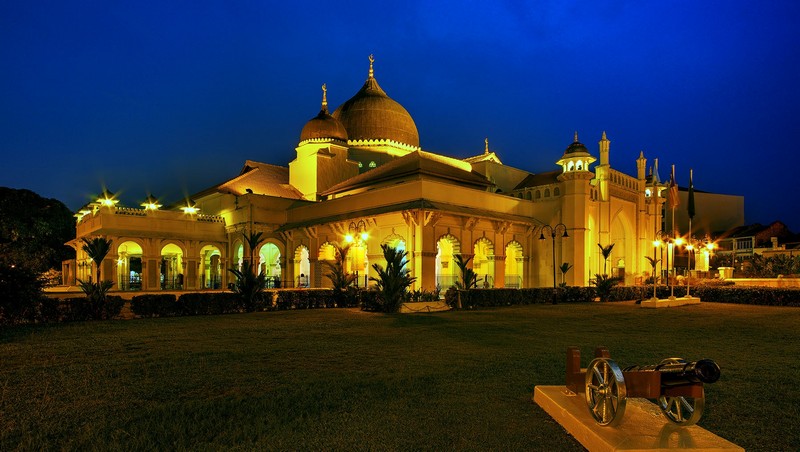
KAPITAN KELING MOSQUE
Kapitan Keling Mosque is a Penang landmark. Built in 1801 by Penang’s first Indian Muslim settlers (East India Company troops), the Indo-Moorish structure is set at the junction of Lebuh Buckingham and Lebuh Pitt. It is the largest mosque in Georgetown and looks sublime at sunset. It was named after the ‘kapitan’ of the Keling (a leader of the South Indian community similar to the leader of the Chinese community), Cauder Mydin Merican. The whitewashed mosque is topped with large golden-yellow Mughal-style domes, crescents and stars and features a single, typical Indian-Islamic minaret from which the sound of the azan (call to prayer) can be heard.
ADDRESS:
14, Jalan Buckingham, George Town, 10200 George Town, Pulau Pinang, Malaysia
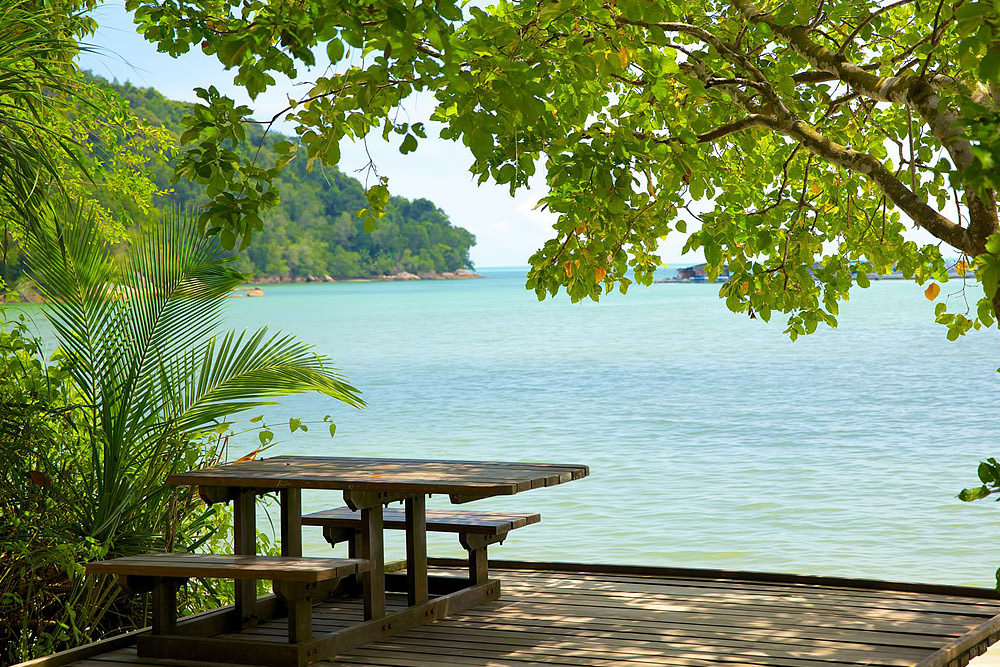
PENANG NATIONAL PARK
Penang National Park is the world’s smallest national park. Within the park are well-marked trails that lead into the jungle and to the bays around; it contains about 410 species of flora and 143 species of fauna ranging from snakes, macaques and leaf monkeys to otters, hawksbill turtles and dolphins.Formerly known as the Pantai Acheh Forest Reserve, it is located further up the west side of Penang Island, past a twisting, forested section of road. Comprising 1181 hectares of forest and 1381 hectares of wetlands, it is a pleasant enough place with a waterfall and a pool for a pleasant swim. Camping facilities are available: telephone the Wildlife Office at Teluk Bahang to make reservations. You will have to register at the office before you can enter the park; Penang National Park is accessible via Teluk Bahang at the end of Batu Ferringhi Road. Bus no. 101 runs a route past Teul Bahang: from there it is a short walk away.
-
TICKET PRICE
There is no entrance fee for visitors to Penang National Park. However, for canopy walkway activity, the fee charged for adults is RM5.00 and RM3.00 for children.
-
Opening Hours:
08:00 – 18:00
Pejabat Taman Negara P. Pinang, jalan Hassan Abbas, 11050 George Town, Penang, Malaysia
VISIT WEBSITE